
We recommend you visit the interactive version. The text to the right is provided for printing purposes.
|
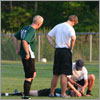

|
|
Traumatic Brain Injuries
Each year, about 1.4 million traumatic brain injuries (TBIs), many of them sports-related, are reported in the United States alone. A TBI occurs when a jolt or blow to the head makes the brain collide with the inside of the skull. Graphic as that sounds, it's not always easy to recognize a mild TBI. An affected player may not lose consciousness or exhibit symptoms immediately, but even a mild brain injury can cause lasting damage. In this slide show, learn about current techniques that detect TBIs and glimpse diagnostic tools that may be used in the future.
|
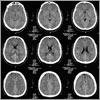

|
|
Computed Tomography
A computed tomography, or CT, scanner uses X-rays to create an image of both bone and brain tissue. CT scans are a first line of screening for severe TBI. With this scan, doctors can see damage to gray matter—the primary type of tissue in regions that manage muscle control, sensory perception, emotion, and speech. But the test, like any type of neuroimaging, requires a trip to the hospital, which may be far from the site of injury. What's more, most experts agree that the scan isn't sensitive enough to detect signs of mild TBI.
|
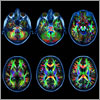

|
|
Diffusion Tensor Imaging
Through Diffusion Tensor Imaging, a type of neuroimaging that builds on MRI technology, doctors can also monitor the health of the brain's white matter. White-matter fibers (called axons) allow communication between brain regions and between the brain and the spinal cord. Damage to this type of tissue may have serious, long-term consequences. In this image, the axons are colored according to orientation. Fibers running between the front and back are blue, those between right and left are red, and those running between the brain's interior and exterior are green.
|
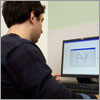

|
|
ImPACT
The trauma-induced change in mental status that often follows a TBI—a concussion—always corresponds with a drop in cognitive ability. In the late 1990s, Dr. Mark Lovell developed ImPACT (Immediate Post-Concussion and Cognitive Testing) to test for that change. This computer program challenges the test-taker to complete a series of tasks that measure attention, memory, response speed, and decision-making. But there's a catch: This test is most useful if the trauma victim completed it at least once before the injury, so that his "injured" score can be compared against his "normal" performance.
|
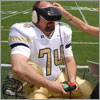

|
|
DETECT
DETECT, the "Display Enhanced Testing for Concussions and mild TBI" system created by the Georgia Institute of Technology and Emory University, is intended for use right on the sidelines of a sports field. The visor, reminiscent of a virtual-reality headset, blocks out distractions while the wearer focuses on a series of digital neuropsychological tests (derived from the standard paper-and-pen version). The device is still in its trial stages and not yet commercially available.
|
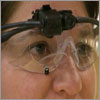

|
|
Eye-Tracking Test
Concussion is also common on the battlefield, where a soldier may be miles from medical care. With funding from the U.S. Department of Defense, Jamshid Ghajar, President of the Brain Trauma Foundation, is developing a concussion test that can be used in combat settings. The prototype seen here contains a high-resolution camera that records the wearer's eye movement as she tracks a moving red dot. Healthy patients follow the circular motion without a problem, but brain trauma victims falter. Ghajar believes this simple test might provide a critical diagnosis in under a minute.
|
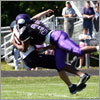

|
|
Head Impact Telemetry System
What if it were possible to detect concussion-inducing trauma at the moment of impact? That's the premise behind the Head Impact Telemetry System (HITS) developed by Simbex. The system (not shown) was designed for use in both sport and military helmets. As soon as the helmet is hit, sensors record information about the blow and transmit that data to a remote computer terminal. Data collected with this kind of system also helps scientists understand how varying forces contribute to traumatic brain injuries.

|
|
|
|
|
|




